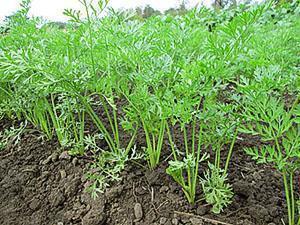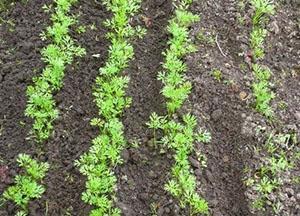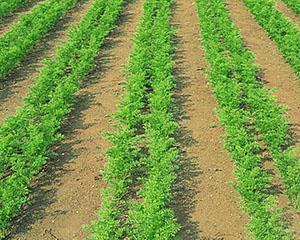Thinning and weeding carrots
 All experienced gardeners know that planting plants is not enough to get a good harvest, they also need to be properly looked after. If we talk about carrots, then the most responsible, painstaking and unloved activities for gardeners are the thinning and weeding of carrots. But, despite this, such work must be done on time and with high quality, otherwise the harvest will turn out to be weak, and the fruits - ugly. If the seeds are planted too densely, then the harvest may not be at all.
All experienced gardeners know that planting plants is not enough to get a good harvest, they also need to be properly looked after. If we talk about carrots, then the most responsible, painstaking and unloved activities for gardeners are the thinning and weeding of carrots. But, despite this, such work must be done on time and with high quality, otherwise the harvest will turn out to be weak, and the fruits - ugly. If the seeds are planted too densely, then the harvest may not be at all.
How to properly weed carrots

Often, in order not to lose carrot seedlings among the weeds during the first weeding, during sowing, seeds of crops such as radish, lettuce or spinach. They sprout much faster, becoming beacons for the gardener, allowing carrots to be weeded without fear of touching the seedlings of this vegetable.
 There are also two opinions about what weather is best for weeding:
There are also two opinions about what weather is best for weeding:
- Some gardeners are more inclined to believe that weeding is best done after a light rain. It is argued that moist soil becomes softer and more pliable for loosening. Weeding is done with a small metal rake. Weeds are pulled out of the ground by hand and discarded. If rain is not expected in the near future, you can water the beds with water before weeding the carrots and wait until they are completely absorbed.
- Other gardeners believe that it is best to weed carrots only in dry and warm weather. The main argument in this case is that the small roots of the weeds that remain in the soil will simply dry out in the sun and prevent the grass from germinating again. They also believe that it is best to pull out young weeds by hand so as not to damage the root vegetable of the vegetable.
Thinning carrots is the key to a delicious harvest
 In the event that the seeds were sown at a distance of 1-2 cm from each other, do thinning carrotsmost likely not needed. If the seeds were poured thickly, with a margin, then the moment will come when it will be necessary to start thinning the beds. The fact is that vegetables planted too close will interfere with each other's growth and development. It is not recommended to delay this process, because during growth the root part of the carrot can intertwine and significantly complicate the removal of some sprouts, and the vegetables themselves will develop much weaker.
In the event that the seeds were sown at a distance of 1-2 cm from each other, do thinning carrotsmost likely not needed. If the seeds were poured thickly, with a margin, then the moment will come when it will be necessary to start thinning the beds. The fact is that vegetables planted too close will interfere with each other's growth and development. It is not recommended to delay this process, because during growth the root part of the carrot can intertwine and significantly complicate the removal of some sprouts, and the vegetables themselves will develop much weaker.
Thinning carrots is usually done twice. To simplify this process, you should use tweezers, which make it much easier to grab the thin stem at the very base. Watch a video at the end of the article on how to properly thin out carrots.
 The first thinning is carried out immediately after the first shoots appear. To facilitate this process, it is better to water the seedlings abundantly beforehand. It is necessary to pull out the carrots strictly upward, not tilting or loosening. If this condition is not met, then you can cut off or damage neighboring shoots.This will contribute to the formation of a branch in the root crop and it will be horned. After the first thinning of carrots, seedlings should remain approximately every 3-4 cm. The remaining plants should be watered with warm water, about two to three liters per square meter. The earth around them needs to be compacted, and between the rows - to loosen. The pulled out shoots of carrots, unlike beets, cannot be transplanted to another place. A too weak root system does not take root.
The first thinning is carried out immediately after the first shoots appear. To facilitate this process, it is better to water the seedlings abundantly beforehand. It is necessary to pull out the carrots strictly upward, not tilting or loosening. If this condition is not met, then you can cut off or damage neighboring shoots.This will contribute to the formation of a branch in the root crop and it will be horned. After the first thinning of carrots, seedlings should remain approximately every 3-4 cm. The remaining plants should be watered with warm water, about two to three liters per square meter. The earth around them needs to be compacted, and between the rows - to loosen. The pulled out shoots of carrots, unlike beets, cannot be transplanted to another place. A too weak root system does not take root.
 The second time the carrots are thinned out after 21 days, when the stems grow up to ten centimeters. After that, the distance between the shoots should remain within 6-7 centimeters. The pulled out seedlings cannot be transplanted either, because they will not be able to take root. In the process, an odor may appear that attracts carrot flies. To avoid this problem, carrot thinning should be done late in the evening or early in the morning.
The second time the carrots are thinned out after 21 days, when the stems grow up to ten centimeters. After that, the distance between the shoots should remain within 6-7 centimeters. The pulled out seedlings cannot be transplanted either, because they will not be able to take root. In the process, an odor may appear that attracts carrot flies. To avoid this problem, carrot thinning should be done late in the evening or early in the morning.
Plugged plants should be thrown into compost and covered with earth. It is also a good idea to sprinkle tobacco on the carrot bed.
Tips for making it easier to weed and thin out carrots
After sowing the beds, they are covered with wet newspapers in about 8-10 layers. Then cover with foil. Thus, a greenhouse is obtained in which moisture is well retained, but, due to the increased temperature, weeds do not germinate. After two weeks, the greenhouse can be removed and the carrot shoots can be expected. This will happen in parallel with the growth of the weeds. After another 10 days, you can weed out the weeds and thin out the carrots.
Thinning and weeding carrots is, of course, the most frustrating part of gardening. It is difficult to sit for hours and carefully look at a plant peeping out of the ground. For some reason, biting and carrots always sprout at the same time, and the seedlings are difficult to distinguish after a long hard work. So summer residents sit in the garden for a long time. Scissors at this moment are unlikely to choose better than fingers what to pull. You can't hesitate. Chicken will quickly take a weak carrot core with its root broom. And if you disturb him, the carrot will be freaky. One way out, rarely sow seeds at once. When thinning, the carrot fly flies to the smell. EM-1 helps me again. In order to sprinkle, little is needed, and the smell beats off, and benefits the plants. Even before thinning, I dilute an alcohol-containing liquid, which some of the citizens ingest. Three spoons per bucket, spray, and the smell does not disappear for several hours. So I save myself from a fly when working on a carrot bed.